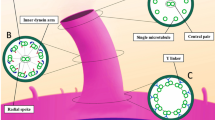Abstract
Wistar Imamichi rat and human respiratory cilia were examined with anti-dynein antibody (AD2), which is specific for sea urchin sperm flagellar dynein. AD2-labelled fresh-frozen normal rat and human cilia stained clearly by immunofluorescence and the peroxidase-antiperoxidase (PAP) technique. On immunoelectron microscopy, AD2 labelled the outer dynein arms of normal human cilia. Paraffin-embedded normal human cilia also stained by immunofluorescence, although not always clearly. Neither the cilia of WIC-Hyd male rats, an animal model of Kartagener's syndrome, nor human cilia from patients with primary ciliary dyskinesia (PCD) reacted positively by the immunofluorescence or PAP technique. Western blots of normal rat cilia yielded a single band of about 450 kDa. In conclusion, AD2 recognizes the outer arm dynein heavy chains of healthy cilia and may be useful in diagnosing and classifying PCD light microscopically especially when only paraffin-embedded specimens are available. This approach may be of potential use for better defining and classifying PCD.
Similar content being viewed by others
References
Afzelius BA (1976) A human syndrome caused by immotile cilia. Science 193:317–319
Brandtzaeg P (1982) Tissue preparation methods for immunocytochemistry. In: Bullock GR, Petrusz P (eds) Techniques in Immunocytochemistry, vol 1. Academic Press, London, pp 1–75
Brokaw CJ, Kamiya R (1987) Bending patterns of Chlamydomonas flagella: IV. Mutants with defects in inner and outer dynein arms indicate differences in dynein arm function. Cell Motil Cytoskeleton 8:68–75
Camner P, Mossberg B, Afzelius BA (1975) Evidence for congenitally nonfunctioning cilia in the tracheobronchial tract in two subjects. Am Rev Respir Dis 112:807–809
Gibbons IR, Rowe AJ (1965) Dynein: a protein with adenosine triphosphatase activity from cilia. Science 149:424–426
Hachiya T, Koizumi T, Hayasaka M, Honda T, Kubo K, Sekiguchi M, Mochizuki I (1993) A case of Kartagener's syndrome with lung cancer. J Jpn Soc Bronchol 15:179–184
Koto M, Miwa M, Shimizu A, Tsuji K, Okamoto M, Adachi J (1987) Inherited hydrocephalus in Csk: Wistar-Imamichi rats; Hyd strain: a new disease model for hydrocephalus. Exp Animal 36:157–162
Laemmli UK (1970) Cleavage of structural proteins during the assembly of the head of bacteriophage T4. Nature 227:680–685
Nogawa S, Toyoda T, Kamo T, Onaka A, Kawai T, Torikata C (1989) A case of immotile cilia syndrome and a review of Japanese cases. Jpn J Thorac Dis 27:505–512
Pollard K, Lunny D, Holgate CS, Jackson P, Bird CC (1987) Fixation, processing, and immunochemical reagent effects on preservation of T-lymphocyte surface membrane antigens in paraffin-embedded tissue. J Histochem Cytochem 35:1329–1338
Rott H-D (1979) Kartagener's syndrome and the syndrome of immotile cilia. Hum Genet 46:249–261
Rutland J, Cole PJ (1980) Non-invasive sampling of nasal cilia for measurement of beat frequency and study of ultrastructure. Lancet Sept. 13:564–565
Sato Y, Mukai K, Watanabe S, Goto M, Shimosato Y (1986) The AMeX method: A simplified technique of tissue processing and paraffin embedding with improved preservation of antigens for immunostaining. Am J Pathol 125:431–435
Sleigh MA (1981) Primary ciliary dyskinesia. Lancet Aug. 29:476
Torikata C, Kawai T, Nogawa S, Ikeda K, Shimizu K, Kijimoto C (1991) Nine Japanese patients with immotile-dyskinetic cilia syndrome: an ultrastructural study using tannic acid-containing fixation. Hum Pathol 22:830–836
Torikata C, Kjimoto C, Koto M (1991) Ultrastructure of respiratory cilia of WIC-Hyd male rats. Am J Pathol 138:341–347
Witman GB (1989) Perspective: Composition and molecular organization of the dynein. In: Warner FD, Satir P, Gibbons IR (eds) The dynein ATPases. (Cell movement, vol 1). Alan R Liss, New York, pp 25–35
Witman GB (1992) Axonemal dyneins. Curr Opin Cell Biol 4:74–79
Yokota T, Ohno N, Tamura K, Seita M, Toshimori K (1993) Ultrastructure and function of cilia and spermatozoa flagella in a patient with Kartagener's syndrome. Intern Med 32:593–597
Yoshida T, Katsuta K, Takanari H, Izutsu K (1989) Analysis of mammalian dynein using antibodies against A polypeptides of sea urchin sperm flagellar dynein. Exp Cell Res 184:440–448
Author information
Authors and Affiliations
Rights and permissions
About this article
Cite this article
Umeda, A., Yamaguchi, K., Kanazawa, M. et al. Immunohistochemical analysis of rat and human respiratory cilia with anti-dynein antibody: comparison between normal cilia and pathological cilia in primary ciliary dyskinesia. Vichows Archiv A Pathol Anat 427, 401–406 (1995). https://doi.org/10.1007/BF00199389
Received:
Accepted:
Issue Date:
DOI: https://doi.org/10.1007/BF00199389




